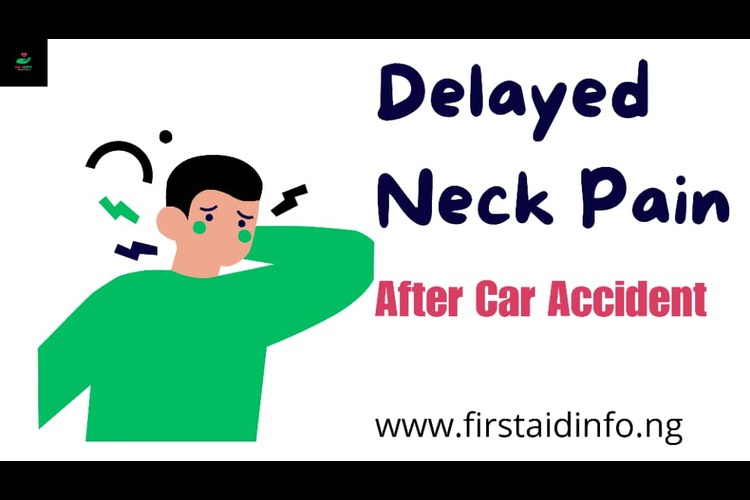When you experience neck pain following a car accident, it’s critical to handle this matter as soon as possible and thoroughly. Understanding the reasons and treatments for delayed neck discomfort, sometimes known as “whiplash,” which is a frequent result of car accidents, is essential for a good recovery and long-term wellbeing.
This article was written to help those suffering from this condition or just an article to help improve your knowledge base.
Understanding Delayed Neck Pain’s Mechanics
Whiplash: What is it?
The word “whiplash” is used to characterize neck injuries brought on by a quick, violent, back-and-forth movement of the head and neck. The head whips backward while the body is propelled forward by the impact of the rear-end collision.
Whiplash’s Frequent Causes
After a car accident, neck pain may persist for some time. The main causes are as follows:
Sudden Deceleration: When a car suddenly stops, the body keeps moving forward, which causes the neck to hyperextend.
Hyperextension and Hyperflexion: The hyperextension (backward movement) and hyperflexion (forward movement) caused by the violent motion of the neck put strain on the neck’s muscles and ligaments.
Injuries to the muscles and ligaments of the neck may result from the forceful movement, which can cause swelling and pain.
Herniated Discs: In extreme circumstances, the power of the collision might herniate discs, putting additional strain on the neck’s nerves.
Understanding the Signs of Delayed Neck Pain
After a car accident, signs of delayed neck discomfort might not appear right away. The soreness frequently takes several hours or even days to become apparent. The following are typical signs of delayed neck pain:
Neck Stiffness: Pain and stiffness that make it difficult to move the neck in different directions.
Recurrent headaches that frequently originate at the skull’s base.
Upper back and shoulder pain:There is discomfort and pain in the upper back and shoulders.
Dizziness and general weariness: general weariness with sporadic vertigo.
Numbness and Tingling: Patients occasionally report feeling numb and tingly in their arms.
Receiving Medical Care For Whiplash
It’s critical to get medical assistance right away if you’ve been in a car accident and believe you may be having delayed neck pain or whiplash. A qualified healthcare provider can offer a thorough assessment and diagnosis. To determine the severity of the damage, they might in some circumstances advise diagnostic imaging tests like X-rays or MRI scans.
Strategies for Treating Delayed Neck Pain
Depending on the extent of the injury, the right course of treatment for whiplash or delayed neck pain must be chosen.
Typical Forms Of Treatment For Whiplash Include
Rest and Ice: In mild cases, resting the neck and applying ice to lessen pain and inflammation are usually advised.
Prescription or over-the-counter pain relievers: Can help with discomfort given by medical doctor.
Physical treatment: Through targeted exercises, physical therapy helps to increase neck strength and mobility.
Chiropractic Care: Spinal realignments made by a chiropractor can relieve pain.
Corticosteroid injections may be advised in specific circumstances to lessen inflammation.
Neck Collar: In extreme situations, a neck collar may be used to immobilize the neck and encourage recovery.
Surgery: In incredibly rare situations with significant injury, surgery may be required.
Rehabilitation and Recuperation For Whiplash
Depending on the person and the severity of the injury, delayed neck pain recovery can vary. Some people can see relief in a matter of weeks, while others would need months of therapy. To ensure a complete recovery, it’s essential to adhere to the specified course of therapy, show up for all scheduled visits, and perform the suggested exercises.
Avoiding Postponed Neck Pain
Driving safely is essential for preventing postponed neck pain. Here are some recommendations to reduce the possibility of whiplash in car collisions.
Make sure your car’s headrest is properly adjusted so that it will support your head and neck in the event of an accident.
Keep a Safe Following Distance: Maintain a safe following distance to lessen the possibility of being rear-ended.
Always use a seat belt to keep yourself firmly in place in case of an accident.
Reduce distractions when driving, such as texting or changing the radio, by staying focused on the road.
Drive safely by following traffic laws and speed restrictions to lower the risk of collisions.
Conclusion
Delayed neck pain, or whiplash, is a common and often painful consequence of car accidents. Understanding the causes and recognizing the symptoms is essential for prompt medical attention and treatment. By following recommended therapies and engaging in rehabilitation, most individuals can achieve a full recovery.
Remember that prevention is key, and practising safe driving habits can significantly reduce the risk of experiencing delayed neck pain after a car accident. Your safety and well-being should always be a top priority when behind the wheel.


